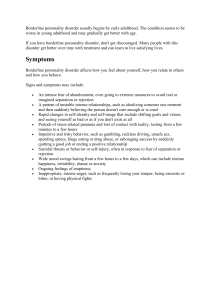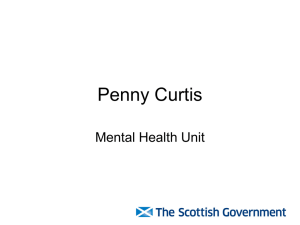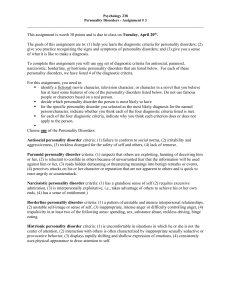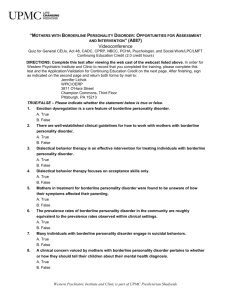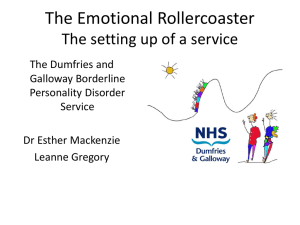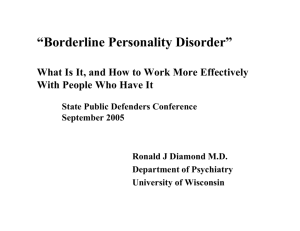Borderline Personality Disorder
advertisement
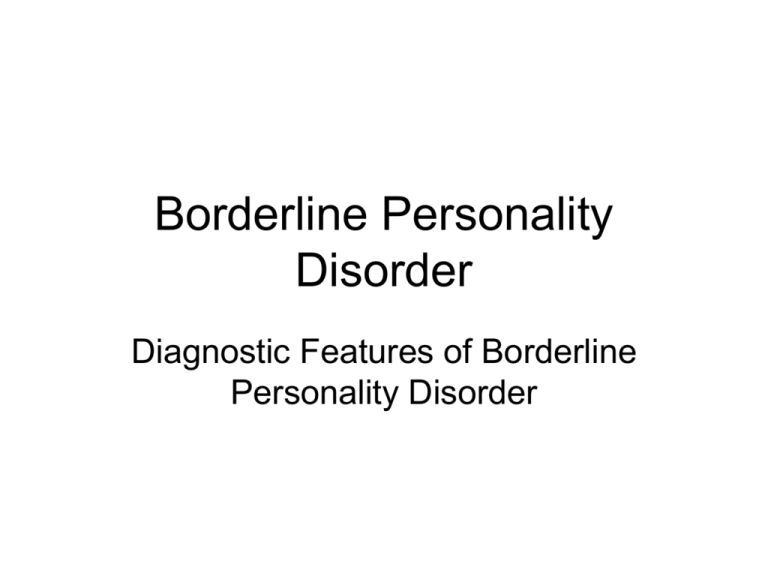
Borderline Personality Disorder Diagnostic Features of Borderline Personality Disorder Diagnostic Features of Borderline Personality Disorder • Criterion 1 – Essential feature is a pervasive pattern of instability of interpersonal relationships – Self-image and affects – Marked impulsivity beginning by early adulthood presenting in variety of contexts – Frantic efforts to avoid real or imagined abandonment Diagnostic Features of Borderline Personality Disorder • Criterion 2 – Have a pattern of unstable and intense relationships Criterion 3 – May be an identity disturbance characterized by markedly and persistently unstable selfimage or sense of self Criterion 4 – Display impulsivity in at least two areas that are potentially self-damaging Diagnostic Features of Borderline Personality Disorder • Criterion 5 – Display recurrent suicidal behavior, gestures or threats, or self-mutilating behavior Criterion 6 May display affective instability that is due to a marked reactivity of mood (e.g., intense episodic dysphoria, irritability, or anxiety usually lasting a few hours and only rarely more than a few days Diagnostic Features of Borderline Personality Disorder • Criterion 7 – May be troubled by chronic feelings of emptiness Criterion 8 Frequently express inappropriate, intense anger or have difficulty controlling their anger Criterion 9 During periods of extreme stress, transient paranoid ideation or dissociative symptoms (e.g., depersonalization) may occur, but these are generally of insufficient severity of duration to warrant an additional diagnosis Diagnostic Criteria for Borderline Personality Disorder • A pervasive pattern of instability of interpersonal relationships, self-image and affects and marked impulsivity beginning by early adulthood and present in a variety of contexts, as indicated by five (or more) of the following: 1. 2. 3. 4. 5. 6. 7. 8. 9. Frantic efforts to avoid real or imagined abandonment. Note: Do not include suicidal or self-mutilating behavior covered in Criterion 5. A pattern of unstable and intense interpersonal relationships characterized by alternating between extremes of idealization and devaluation. Identity disturbance: markedly and persistently unstable self-image or sense of self Impulsivity in at least two areas that are potentially self-damaging (e.g., frequent displays of temper, constant anger, recurrent physical fights). Recurrent suicidal behavior, gestures or threats, or self-mutilating behavior. Affective instability due to a marked reactivity of mood (e.g., intense episodic dysphoria, irritability or anxiety usually lasting a few hours and only rarely more than a few days). Chronic feelings of emptiness. Inappropriate, intense anger or difficulty controlling anger (e.g., frequent displays of temper, constant anger, recurrent physical fights). Transient, stress-related paranoid ideation or severe dissociative symptoms. Source: Reprinted with permission from DSM-IV-TR (APA 2000, pp. 706-708, 710). Advice to the Counselor: Counseling a Client with Borderline Personality Disorder • Anticipate that client progress will be slow and uneven. • Assess the risk of self-harm by asking about what is wrong, why now, whether the client has specific plans for suicide, past attempts, current feelings and protective factors. • Maintain a positive but neutral professional relationship, avoid over-involvement in the client’s perceptions and monitor the counseling process frequently with supervisors and colleagues. • Set clear boundaries and expectations regarding limits and requirements in roles and behavior. • Assist the client in developing skills (e.g., deep breathing, meditation, cognitive restructuring) to manage negatie memories and emotions.
